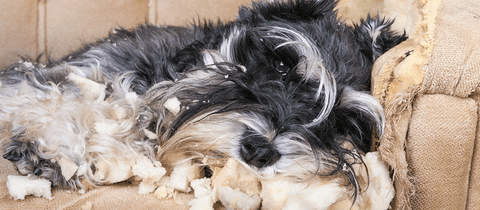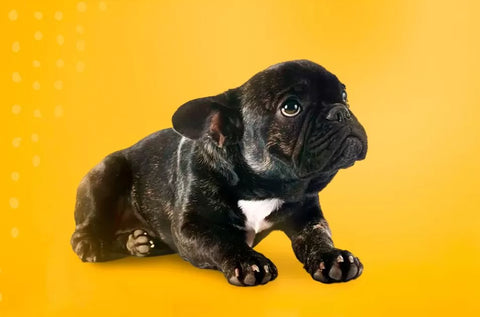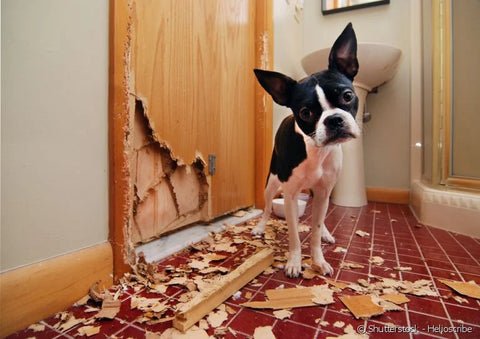on purchases over €75
on purchases over €75


Just like people, dogs can be scared, nervous and anxious. I have a friend whose dog suffers from severe anxiety issues. Anxiety attacks occur when it rains, thunders, or the wind howls a little too loudly. Your dog doesn't like loud noises and even gets anxious when the vacuum cleaner or dishwasher is running. As a way of relieving stress, the dog paces around or tries to hide behind furniture. With anxiety, it also rips and bites the tutor's clothes and bedding. Despite all this, my friend refuses to give the dog anxiety medication.
We may or may not agree with this decision, but I think it doesn't hurt to start by trying the natural way!
When it comes to canine anxiety, there are a number of things you can do to help comfort and calm your furbaby. Then I share 7 ways to do it!
But first, let's take a closer look at anxiety in dogs.

The first step to alleviating your dog's anxiety is identifying the exact cause. Anxiety in dogs can be triggered by a number of things.
Situational/fear related - means your dog is afraid of something specific like the vet, the clipper, car rides, storms or loud noises. If you've adopted a new dog from an institution or shelter, your fears are likely deeply rooted in a healing past experience.
Behavioral anxiety such as separation anxiety .
Once you've identified the exact trigger, work with your dog to help him overcome these fears. Dog behavior expert Kathy Reilly said:
“ Work to change his mind about specific triggers by associating something good with something scary. In other words, if your dog is afraid of the mailman, try giving him treats as soon as the mailman shows up and don't stop until the mailman leaves. With each practice you will see your dog react less and less. This is because you changed the association with the postman. It stops being a threat, becoming an association with cookies. Over time, you will need less and less treats because your dog will stop being afraid of the postman. ”
Likewise, if your dog is afraid of an object, like the vacuum cleaner for example, turn it off and leave it nearby while you feed your dog a tasty meal or give him some biscuits. Reward good behavior!
As you work with your dog to change the behavior at root, the ideas below may help bring your anxious pup some relief.

Before your puppy goes through a stressful situation (for example, a trip to the vet, a groomer or a ride in the car), it's great to do some exercises and brain games. Going for a walk around your neighborhood, playing Frisbee, tossing the ball for a game of fetch or playing with a train toy will help tire your dog out and act as a great stress reliever for two main reasons:

CBD for dogs can bring some improvements: for example for joint pain, as a soothing for seasonal allergies and also to improve mood.
How does it work exactly? Well, it's all about the endocannabinoid system (ECS) which was first discovered in the early 1990's when scientists were exploring the cannabis plant.
So what exactly is ECS? Well, let's break the word down:
Therefore, “endocannabinoid” simply means cannabis-like substances that occur naturally in the body.
The ECS is made up of three parts:
According to Dogs Naturally Magazine:
“ Your dog's body releases endocannabinoid chemicals on its own. These connect with receptors that stimulate the natural ability to create serotonin. Serotonin is a natural mood stabilizer. Research shows that CBD enhances this ability. It interacts with the nervous system to ease and calm anxiety. ”

DAP is a synthetic chemical based on a hormone produced by lactating bitches. It is this hormone that helps keep puppies calm. While scientific studies show that DAP works with puppies, researchers say it's unclear whether DAP works with anxious adult dogs. However, DAP did help calm my friend's dog down and it's definitely worth a try!
DAP comes as a plug-in diffuser with bottles that last 30, 60 or 90 days. Don't worry about the smell: humans can't smell. Plus, there's also a spray bottle, perfect for travel!
Lavender is known as the best calming agent and can help your dog overcome stress. Many owners swear by simply rubbing a little essential oil into their dog's fur to help calm them down during a thunderstorm or a car ride. But don't take my word for it. The effects were tested in 2006 during a clinical study that examined 32 dogs with a history of travel-induced arousal. The results? Dogs spent significantly more time resting and sitting and less time moving and vocalizing when exposed to the scent of lavender versus no scent. Before using essential oils on your dog, be sure to dilute them with a carrier oil – such as coconut, almond or olive oil.

Music can be extremely effective in calming your anxious dog. While you could simply fire up Pandora or Spotify and play some soothing music, there are playlists specifically designed to soothe canine anxiety.
For example, the company Through a Dog's Ear offers a selection of soothing music for pets. It comes preloaded with 4 hours of clinically tested music.
A protective vest is much like the blankets we use to wrap a baby around to give him a sense of security. Tightly wrapped clothing applies pressure to your dog's body, promoting a sense of comfort and security. This continuous pressure is believed to calm an anxious dog's nerves!

It's no secret that most dogs love to be petted, rubbed and massaged. Heck, when I stop petting my puppies, they immediately reach out and start scratching my hand. It's their way of saying, “Don't stop! Keep going!" In addition to feeling good, did you know that a regular massage has many health benefits for your dog? In addition to improving blood circulation, aiding digestion and relieving muscle tension, a canine massage can actually promote relaxation and ease the anxiety!
*Note: If your dog suffers from severe anxiety, you should consult your veterinarian.
{"one"=>"Select 2 or 3 items to compare", "other"=>"{{ count }} of 3 items selected"}
Leave a comment